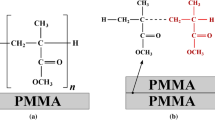Abstract
Based on qualitative and quantitative criteria, solvents compatible with polymethyl methacrylate (PMMA) such as ethyl acrylate, n-butylacrylate, and vinyl acetate were selected. Features of the solvent-bonded seam of non-detachable bonding of PMMA of various grades obtained using the selected solvents were investigated. It is shown that the method of chemical solvent bonding with vinyl acetate can be an alternative to gluing in sealing of microchips, since the solvent-bonded seam makes a smaller contribution to the change in the working volume of microstructures than the glue seam.

Similar content being viewed by others
REFERENCES
A. A. Evstrapov, “Microfluidic chips for biological and medical research,” Russ. J. Gen. Chem. 82, 2132–2145 (2012). https://doi.org/10.1134/S107036321212033X
T. M. Zimina and V. V. Luchinin, “Microsystems for express analysis,” Zh. Anal. Khim. 66 (12), 1252 (2011).
M. L. Zanaveskin, A. A. Mironova, and A. M. Popov, “Microfluidics and its prospects in medicine,” Mol. Med.: Kvartal. Nauchno-Prakt. Zh., No. 5, 9–16 (2012).
I. A. Platonov, V. I. Platonov, I. N. Kolesnichenko, and M. G. Goryunov, “Microfluidic systems in gas analysis (review),” Sorbtsionnye Khromatogr. Protsessy 15 (6), 754–768 (2015).
A. S. Yakimov, E. D. Osipova, A. V. Morgun, E. B. Boitsova, P. I. Belobrov, V. V. Salmin, and A. B. Salmina, “Measuring microfluidic system for the cultivation of mammalian brain cells,” Nauchn. Priborostr. 29 (4), 51–56 (2019). https://doi.org/10.18358/np-29-4-i5156
V. A. Petrov, T. N. Gerasimenko, O. V. Kindeeva, I. N. Gazizov, S. A. Shilin, and D. A. Sakharov, “Developing a microfluidic device with an integrated electrode system for measuring the impedance spectra of cellular models in real time,” Bull. Russ. Acad. Sci. Phys. 84, 147–150 (2020). https://doi.org/10.3103/S1062873820020288
T. A. Lukashenko, A. N. Tupik, G. E. Rudnitskaya, A. L. Bulyanitsa, A. I. Tsymbalov, and A. A. Evstrapov, “Methods of thermal, adhesive, and chemical bonding with a solvent in the manufacture of polymer and polymer-glass microchip devices,” Nauchn. Priborostr. 26 (2), 64–74 (2016). https://doi.org/10.18358/np-26-2-i6474
S. Ahmed, D. Chakrabarty, S. Bhowmik, and S. Mukherjee, “Comparative studies of solvent bonding and adhesive bonding for fabrication of transparent polymers,” Surf. Eng. Appl. Electrochem. 52, 193–201 (2016). https://doi.org/10.3103/S1068375516020022
S. H. Ng, R. T. Tjeung, Z. F. Wang, et al., “Thermally activated solvent bonding of polymers,” Microsyst. Technol. 14 (6), 753–759 (2008). https://doi.org/10.1007/S00542-007-0459-1
M. T. Koesdjojo, C. R. Koch, and V. T. Remcho, “Technique for microfabrication of polymeric-based microchips from an SU-8 master with temperature-assisted vaporized organic solvent bonding,” Anal. Chem. 81 (2), 1652–1659 (2009). https://doi.org/10.1021/ac802450u
S. S. Volkov, Welding and Bonding of Polymeric Materials (Khimiya, Moscow, 2001) [in Russian].
T. A. Lukashenko, A. N. Zubik, A. L. Bulyanitsa, and A. A. Evstrapov, “Features of a non-detachable adhesive bonding of parts of microfluid devices from polymethyl methacrylate,” Polym. Sci. Ser. D 14, 222–226 (2021). https://doi.org/10.1134/S1995421221020155
http://megatakt.com/materialy.html. Accessed August 7, 2020.
http://www.acryma.ru. Accessed August 7, 2020.
http://www.nicp.ru/ru/52/55/. Accessed August 7, 2020.
A. P. Kondratov and G. N. Zhuravleva, Physics and Chemistry of Materials and Technological Processes: Methodical Instructions for Writing Term Papers (MGUP im. I. Fedorova, Moscow, 2016) [in Russian].
https://xumuk.ru/encyklopedia/2/3533.html. Accessed August 7, 2020.
Funding
This work was carried out within the framework of state assignment of the Ministry of Science and Higher Education of the Russian Federation no. 075-01073-20–00.
Author information
Authors and Affiliations
Corresponding author
Additional information
Translated by K. Lazarev
Rights and permissions
About this article
Cite this article
Lukashenko, T.A., Zubik, A.N., Bulyanitsa, A.L. et al. Solvents for Sealing Microfluidic Devices Made of Polymethyl Methacrylate by Chemical Solvent Bonding. Polym. Sci. Ser. D 14, 350–355 (2021). https://doi.org/10.1134/S1995421221030175
Received:
Revised:
Accepted:
Published:
Issue Date:
DOI: https://doi.org/10.1134/S1995421221030175




